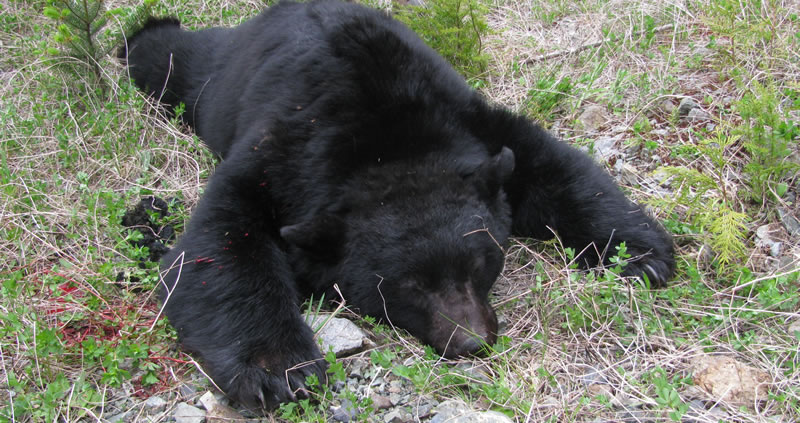
Field judging Black Bears can sometimes be difficult even for the most experienced of bear hunters.
The animal you are judging is usually completely black aside from color phase bears, they have thick fur and the shadows they create can be decieving. With that said there are a few methods you can have at your disposal to help you determine if the bear is a shooter or not.
So how can you improve your skills at judging trophy black bear size in the field?
First of all…. Determine what you’re going to be doing with this bear.
A: I will be shooting this bear for the meat.
B: I will be shooting this bear for the hide/skull/trophy. (you have to take the meat to in BC)
If you answered A: Then your field judging is dirt simple. Make sure the bear is NOT in a family group (sow with cubs) and the closer to a road the better. That was easy, wasn’t it??!
If you answered B: Then you’ve got a bit of a tougher job to learn to observe and determine what you are looking at. The good news is, the more bears you are able to get close to and observe, the easier this practice becomes.
Let’s Get Started.
Check Out The Bears Head:
Big Bears: Will have a very large, blocky looking head. Their ears will look small, and almost off to the side of their skull a little. On really big boars you might even see a crease down the center of their forehead, if that’s the case, it’s a good bear. Other features to look for on a bears head would be scarring around the face, boars have ferocious fights, so it’s not uncommon for them to have plenty of battle scars around their muzzle, eyes and ears and these are helpful clues.
Small Bears: Will have a small, narrow head, almost dog like. Their ears will appear to be much larger and defined. Almost like “Mickey Mouse” is a common description among many experienced bear hunters.
Check Out The Bears Behavior:
Big Bears: Big dominant boars, behave like big dominant boars. And they usually won’t be in much of a hurry unless they know you’re there and you’ve spooked him. When big boars walk they will sometimes have a big swagger to their stride, much moreso then a bear who’s on the submissive end of the spectrum. When I shot my first Island Black Bear we watched him stand up on two legs and scratch his back on a tree for a couple minutes, without a care in the world. When big boars decide to move they move deliberately, there is no indecision in their movements which can be noticed in younger, startled and confused bears. Because they are dominant, the big boars will usually have a bit of a schedule and will often be caught feeding in the same places, at the same times of day. They can do this because they are the boss!
Small Bears: Are very cautious, they will get out of your way quickly (so will a big old boar too if he’s spooked). They will usually always be more alert then a dominant bear because they have to be, or they could become dinner. Smaller bears will often seek the safety of a tree when in trouble or they just won’t stop running until they hit the coast. When small bears run, they will appear much more agile then a larger bear. They will will look more like a big dog running, then a lumbering old boar.
*Tip – When you’re observing a bear, and he/she doesn’t appear to be spooked, sit there and watch them for 1/2 hour or so. Bears are pretty fascinating creatures when you watch them do their thing, and by observing you’ll learn more about them and that makes the hunt more fun.
Check Out The Bears Body:
Big Bears: Sometimes the big boys are called “belly draggers” for a reason, and it’s possible for Island Bears to get this big. Big Boars may appear to be so big, you can’t see underneath their body when they are moving around. That’s a big bear! If the bear you’re looking at appears to have long legs, it’s probably because he has a smaller body in proportion. Big bears will have very muscular looking arms and legs, especially their front shoulders/neck area.
Small Bears: Can you picture the size of a really large breed dog? OK. That’s about the size of an “average” Island Black Bear. An average Island Bear will weigh 150-250lbs. An large 6’+ boar could likely weigh 300+ and the big bears do look much different as you can see in the photos.
What Are Some Additional Signs Of A Big Bear?
If it’s a big bear you’re after then you need to pay attention to the sign you see around you. Tracks and Scat are very good indicators as to the potential size of a bear, and will let you know if a particular bear is frequenting an area.
Judging Bear Size From Tracks:
This method was shown to me by my Father who was a big game guide for nearly 30 years. It has since been shown to me by several taxidermists and many more experienced bear hunters than I so I believe in this method.
If you can find fresh bear tracks in an area, maybe mud or soft sand (common where we hunt spring bear on the Island) measure the distance across the front pad and simply add 1. This will give you a rough “square” of the bear. So if you measure the bear track and it came out at 5″inches across, you would add 1 and could guesstimate that bear was roughly a 6′ foot bear.
I have tried this method on many of our harvested black bears and I have to say it’s pretty damn close! The only problem with this method is you need to find the bear that left the track!
Judging Bear Size From Scat:
Spend a couple days bear hunting on the Island and you’ll observe several dozen or so piles of bear scat scattered across the road. Not only can they help you see what the bears are eating but they can give you a pretty good indicator as to the size of the bear that left it. Here’s a tip for you. It’s not necessarily the size of the pile… It’s the diameter of the nuggets! A really BIG bear has a really big butt and it’s not uncommon for them to leave scat the diameter of a beer can behind! If you look at 10 piles of bear scat and then come across the one left by the big kahuna trust me… You’ll Know!
If you discover an area that has BIG tracks and some BIG (large diameter) scat, then it might be worth hunting that area a little harder. Big Island Black Bears don’t have enormous ranges and unless you’ve spooked them heavily they will keep coming back to the same places to feed.
Hopefully you found article helpful and through experience you’ll become a much better bear hunter. Because of their abundance it’s pretty easy to rack up experience if you’ve got the time to put a couple weekends in every year and then the patience to watch and observe what goes on around you. Pay attention to the sign, and have a good time out there!
Carl
BCHuntingBlog

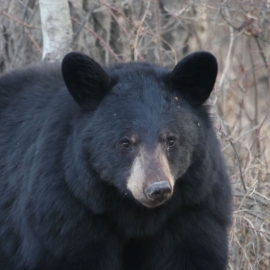
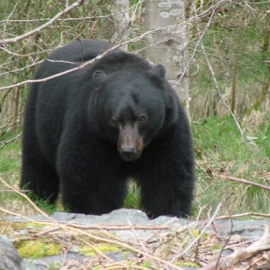
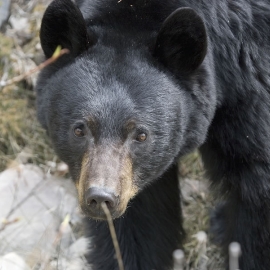
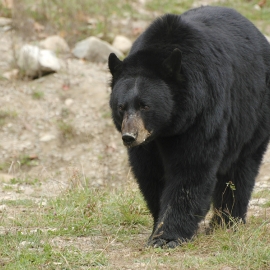
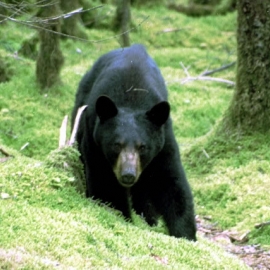

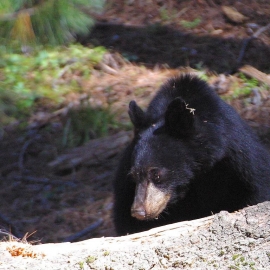
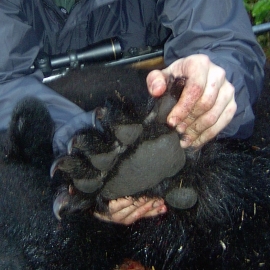

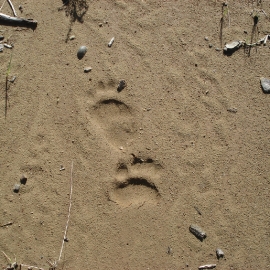
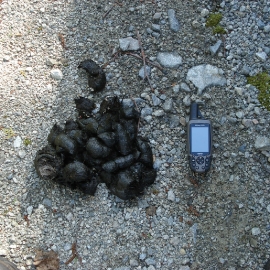

My first bb hunt is coming up labor day for a week Although I’ve killed a few whitetails Not sure on judging bb your article was quite informing I want to take a bear but not a baby I would rather eat the tag than take a juvenile bear not pressed to get a monster any adult would be fine. Oh by the way I’m a bow hunter and wont shoot one with a gun that’s just not for me
thank you mark mcdaniel rockville indiana
Hi Mark,
Thanks for your comment. You’ll know a good bear when you see one, don’t rush yourself and look at as many as you can. In BC, on the Island I’ve been fortunate enough to see literally hundreds of black bears in the field and have been in on several successful hunts. The more bears you see the easier it is too judge.
Carl
hi been hunting from april to june now all i have seen is scat LOTS but no bears i have been to hope and just passed whistler and in the squamish area just to see one would be good.but love to take one to but with not seeing one man.when you do mite not be the one you can take.were is a good place to see black bears? please help
Hi Sean,
I don’t hunt bear very much on the mainland but certainly don’t have any trouble on the Island. On the Island I generally look for cuts/slashes that are a couple of years old with lots of vegetation. Deactivated/recontoured roads that they have reseeded with grass and clover are excellent spots to glass mid to late afternoon. Now that it’s June they are starting to rut which means you’re more likely to find a good boar following a sow now. It doesn’t take much to hide a black bear in a clear cut so you need to spend some time glassing, don’t just drive around.
You could also try http://www.huntingbc.ca as there are many members from Vancouver who might be able to offer more strategic advice for your area.
Does “6′” mean the height of the bear standing?
Hi Gail,
The 6′ would refer to the overall length of the bear from nose to tail.
I am planning my first spring bear hunt this year and this just helped me out major thank you awesome thread
Leaving for my first bear hunt 8/17/18 Ontario Canada, this has been a lot of good info thanks to all.
Thanks Mike, Good luck on your hunt!